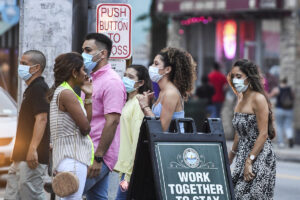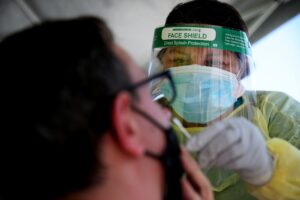Coronavirus
“You don’t have to do them all. But [the] more you do, the more you keep folks safe. And ensure safe in-person learning.”
There are five important tools essential to keeping schools safe for full-time, in-person learning this fall, according to Dr. Ashish Jha.
Jha, dean of Brown University’s school of public health, wrote on Twitter that vaccination, ventilation, masking, testing, and distancing are the most effective strategies to ensure COVID-safe schools. Each measure, he noted, is broadly available for any district to implement.
Districts serious about safe, in-person education, Jha said, should mandate vaccination for all adults in schools, with the typical exceptions. Districts should also consider mandating vaccines for kids 12-years-old and older, he said, which would protect kids that can’t get vaccinated.
When it comes to ventilation — it’s a no-brainer, Jha said, and districts are lagging behind if no improvements have been made already.
“SARS-CoV2 spreads through the air. Congress gave Billions of $ to upgrade schools. Schools have had a year to do it,” Jha wrote. “Upgrades [are] largely cheap (in-room portable air filters, opening windows). Any school that hasn’t improved ventilation needs a change in leadership.”
Jha called masking “unnecessarily controversial.”
“People – can we please stop fighting about this?” He wrote. “Masking helps. Cloth masks help a little. Higher quality masks (KF94, etc.) should be considered in high transmission areas. They are cheap and widely available.”
Like masking, Jha noted that testing is broadly available, and options like pooled testing are pretty cheap.
“We now have so much testing capability and capacity,” he wrote. “We have plenty and schools have plenty of money. No excuse not to do testing.”
The fifth tool — distancing — has been widely debated as schools with crowded classrooms, hallways, and cafeterias bring all students back full-time. Jha recommended avoiding assembly halls and indoor concerts as Delta surges, and managing lunchtime with distancing, open windows, and using outdoor space. These actions, he said, will be critical over the next month as Delta peaks and begins to go down.
Though Jha recommends all five tools, some are better than none.
“Each adds protection. None alone enough in high transmission areas,” he wrote. “You don’t have to do them all. But [the] more you do, the more you keep folks safe. And ensure safe in-person learning.”
Newsletter Signup
Stay up to date on all the latest news from Boston.com






